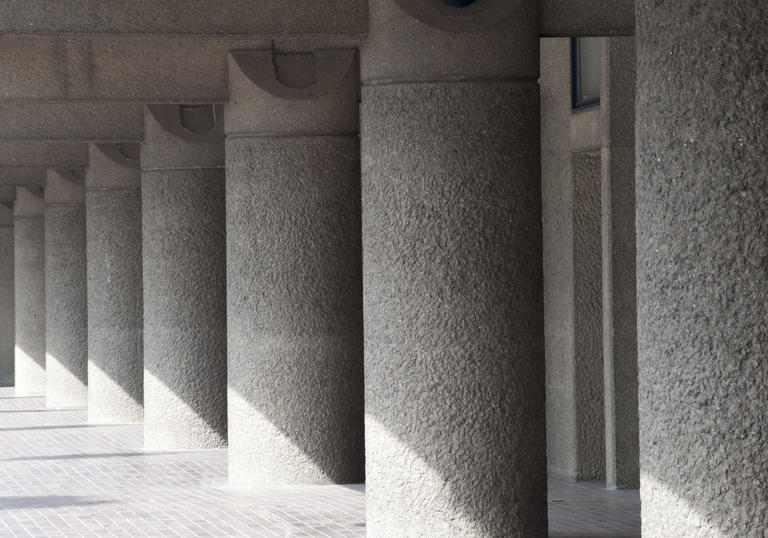How long have you been working at the Barbican?
You’ll get an idea if I tell you that I first worked here on the exhibition installation crew. I can truly say that there has never been a dull moment. There has always been some incredible new project to keep me here, a promotion or two and every now and again, a complete change of programming direction to keep me on my toes. I’ve always been acutely aware of the responsibility that comes with this job and the privilege of working with art in such a direct way.
Talk us through your average working day.
I like to get in earlyish so that I get a head start. I tend to look at my e-mails over a coffee, unless I have something urgent to prepare. I also like to tidy my desk, do a bit of quick basic filing – I can’t work with mess. I also check my diary – just to be sure I know how my day is going to pan out. It’s important to speak to my colleagues. First thing in the morning is often a good time to have an informal chat about their news. There is always something exciting afoot to share – yesterday my colleague, Lydia Yee, was telling me about how she had been negotiating exciting new loans from the British artist, Howard Hodgkin. Predictably, I tend to have an overload of meetings through the day – sometimes it’s crazy! Meetings can be very various – about different exhibitions, 1:1s with staff, meeting other senior colleagues to discuss strategy or the future programme. Much of what I do is about trying to persuade people to work with us or selling what we do. The ability to network is crucial – it’s amazing what can happen as a result of a chance meeting over dinner.
What is the best part of your job?
At the moment we are installing a kinetic light and sound installation by United Visual Artists. It’s so brilliant to be able to commission a brand new major piece of work that supports the artist’s development and then make it possible for visitors to see this work for free. Being in Rain Room and seeing the Wayne McGregor dance intervention literally brought tears to my eyes…. it was truly magical to see the impact it had. After something like two years in the planning, a main gallery exhibition finally comes together in the space – it can be a revelation even to the curator and a joy when you know it’s going to work out and be truly special. Equally, it’s amazing to be able to get so close to such incredible works of art. And then there is the pleasure of working in a team – all the parts need to work together. I believe staff should be empowered to work to their full potential and it’s great to see them succeeding.
The ability to network is crucial – it’s amazing what can happen as a result of a chance meeting over dinner
What is the most challenging part of your job?
These are tough economic times and as we don’t have a collection, we can’t get what we want by bartering loans. Some installations can be very demanding – for instance, you can imagine the level of plumbing sophistication that was required for Rain Room! And it was the first time it had been attempted. You have to be OK with taking risks. It’s great to work directly with artists but for obvious reasons they are not going to be interested in compromising their vision or being told we don’t have the money.
Do you have a favourite spot in the Barbican Centre or Estate?
That’s an interesting question! There is a place in the Barbican where hardly anybody ever goes – standing directly under the bridge that crosses the lake. You really a get sense of the grandeur, monumentality and uniqueness of the architecture. It has a curiously Japanese feeling under there. I once got onto the roof of Shakespeare Tower – it was extraordinary, but I couldn’t wait to get down! I‘m also a fan of the terrapin pool – not many people know about that. I love the serrated edges of the towers too.
What was the first performance or exhibition you saw at the Barbican?
I remember seeing a Gwen John exhibition before I worked here (in 1985) and being blown away by one single painting, ‘Nude Girl’, which is in the Tate collection in fact.
What is your best Barbican memory or experience?
The pinnacle of my curatorial career to date was most certainly, The Surreal House, in 2010.
You need to be alive to what art can bring and be good at working as part of a team.
Outside the Barbican, what is your favourite thing to do/favourite place in London?
Columbia Road comes to mind – it such a pleasure on a Sunday morning – so London. I love walking on Hampstead Heath as well. In terms of museums, I’ve always been a great admirer of the V&A.
Do you have any advice for people interested in pursuing a career in curation?
Yes, I always tell aspiring interns to be very strategic in their choice of roles, think about who inspires them, to develop a specialism and be proactive about making things happen. It’s not enough to just work hard – I’ve come to understand the crucial importance of building a network of contacts. Young women need to believe in themselves too. You need to be alive to what art can bring and be good at working as part of a team. A generosity of spirit is essential and problem solving ability and good communication skills.
Describe the Barbican in five words.
Where great art comes alive

